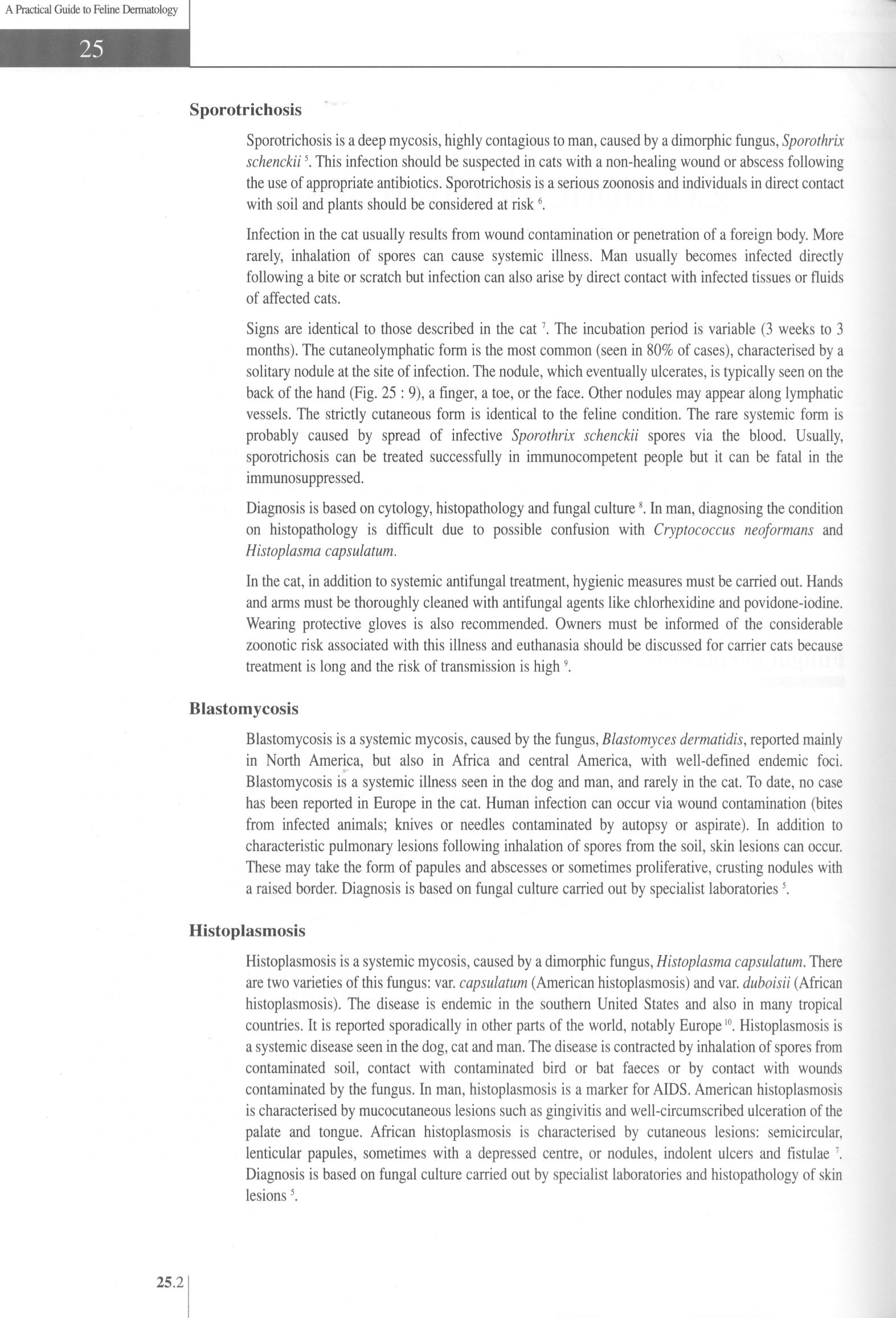252 (18)

25
A Practical Guide to Feline Dermatology
Sporotrichosis
Sporotrichosis is a deep mycosis, highly contagious to man, caused by a dimorphic fungus, Sporothrix schenckii5. This infection should be suspected in cats with a non-healing wound or abscess following the use of appropriate antibiotics. Sporotrichosis is a serious zoonosis and individuals in direct contact with soil and plants should be considered at risk6.
Infection in the cat usually results from wound contamination or penetration of a foreign body. Morę rarely, inhalation of spores can cause systemie illness. Man usually becomes infected directly following a bite or scratch but infection can also arise by direct contact with infected tissues or fluids of affected cats.
Signs are identical to those described in the cat7. The ineubation period is variable (3 weeks to 3 months). The cutaneolymphatic form is the most common (seen in 80% of cases), characterised by a solitary nodule at the site of infection. The nodule, which eventually uleerates, is typically seen on the back of the hand (Fig. 25 : 9), a finger, a toe, or the face. Other nodules may appear along lymphatic vessels. The strictly cutaneous form is identical to the feline condition. The rare systemie form is probably caused by spread of infective Sporothrix schenckii spores via the blood. Usually, sporotrichosis can be treated successfully in immunocompetent people but it can be fatal in the immunosuppressed.
Diagnosis is based on cytology, histopathology and fungal culture8. In man, diagnosing the condition on histopathology is difficult due to possible confusion with Cryptococcus neoformans and Histoplasma capsulatum.
In the cat, in addition to systemie antifungal treatment, hygienic measures must be carried out. Hands and arms must be thoroughly cleaned with antifungal agents like chlorhexidine and povidone-iodine. Wearing protective gloves is also recommended. Owners must be informed of the considerable zoonotic risk associated with this illness and euthanasia should be discussed for carrier cats because treatment is long and the risk of transmission is high9.
Blastomycosis
Blastomycosis is a systemie mycosis, caused by the fungus, Blastomyces dermatidis, reported mainly in North America, but also in Africa and central America, with well-defined endemic foci. Blastomycosis is a systemie illness seen in the dog and man, and rarely in the cat. To datę, no case has been reported in Europę in the cat. Humań infection can occur via wound contamination (bites from infected animals; knives or needles contaminated by autopsy or aspirate). In addition to characteristic pulmonary lesions following inhalation of spores from the soil, skin lesions can occur. These may take the form of papules and abscesses or sometimes proliferative, crusting nodules with a raised border. Diagnosis is based on fungal culture carried out by specialist laboratories5.
Histoplasmosis
Histoplasmosis is a systemie mycosis, caused by a dimorphic fungus, Histoplasma capsulatum. There are two varieties of this fungus: var. capsulatum (American histoplasmosis) and var. duboisii (African histoplasmosis). The disease is endemic in the Southern United States and also in many tropical countries. It is reported sporadically in other parts of the world, notably Europę10. Histoplasmosis is a systemie disease seen in the dog, cat and man. The disease is contracted by inhalation of spores from contaminated soil, contact with contaminated bird or bat faeces or by contact with wounds contaminated by the fungus. In man, histoplasmosis is a marker for AIDS. American histoplasmosis is characterised by mucocutaneous lesions such as gingivitis and well-circumscribed uleeration of the palate and tongue. African histoplasmosis is characterised by cutaneous lesions: semicircular, lenticular papules, sometimes with a depressed centre, or nodules, indolent uleers and fistulae 7. Diagnosis is based on fungal culture carried out by specialist laboratories and histopathology of skin lesions5.
25.2
Wyszukiwarka
Podobne podstrony:
254 (18) 25 A Practical Guide to Feline Dermatology 25 A Practical Guide to Feline DermatologyBacter
256 (18) 25 , Practical Guide to Feline Dermatology Prophylactic measures should, therefore, be take
274 (18) 27 A Practical Guide to Feline Dermatology Colitis 11.2 Collagen 1.2,2.6,12.1,
67 (125) 6 A Practical Guide to Feline DermatologyNocardiosisAetiopathogenesis Nocardiosis is a very
510 (5) A Practical Guide to Feline DermatologyCoccidioidomycosisAetiopathogenesis Coccidioidomycosi
33 (337) 3 A Practical Guide to Feline DermatologyCheyletiellosisAetiopathogenesis Cheyletiellosis i
278 (17) 27 A Practical Guide to Feline Dermatology I J Histoplasmosis 5.8, 7.8, 25.2 Homer’s syndro
58 (148) 5 A Practical Guide to Feline Dermatology severity of the illness. High titres are seen wit
65 (127) 6 A Practical Guide to Feline Dermatology Other topical antimicrobial agents, such as chlor
69 (119) 6 A Practical Guide to Feline DermatologyDiagnosis The diagnosis is based on lesion distrib
710 (2) 7 A Practical Guide to Feline DermatologyHerpesvirus infections Dermatological manifestation
74 (105) 7 A Practical Guide to Feline Dermatology ulcerated. Lesion distribution is multicentric bu
27 A Practical Guide to Feline Dermatology Perianal glands 1.7 Permethrin 3.12, 3.13 Persian 1.6,2.2
27 A Practical Guide to Feline Dermatology Stemphyllium spp. 5.1,7.8 Stereotypie behaviour 17.1,
272 (16) 27 A Practical Guide to Feline Dermatology Alternaria spp. 5.1,7.8 Aluminium hyroxide 15.6&
28 (374) 2 A Practical Guide to Feline Dermatology Configuration of lesions Determining the configur
313 (14) A Practical Guide to Feline Dermatology The second phase consists of long-term control of t
31 (328) 3 A Practical Guide to Feline Dermatology Sarcoptic mange Sarcoptes scabiei var canis (Tabl
82 (128) 8 A Practical Guide to Feline Dermatology considered important parasites. Cats in the Unite
więcej podobnych podstron